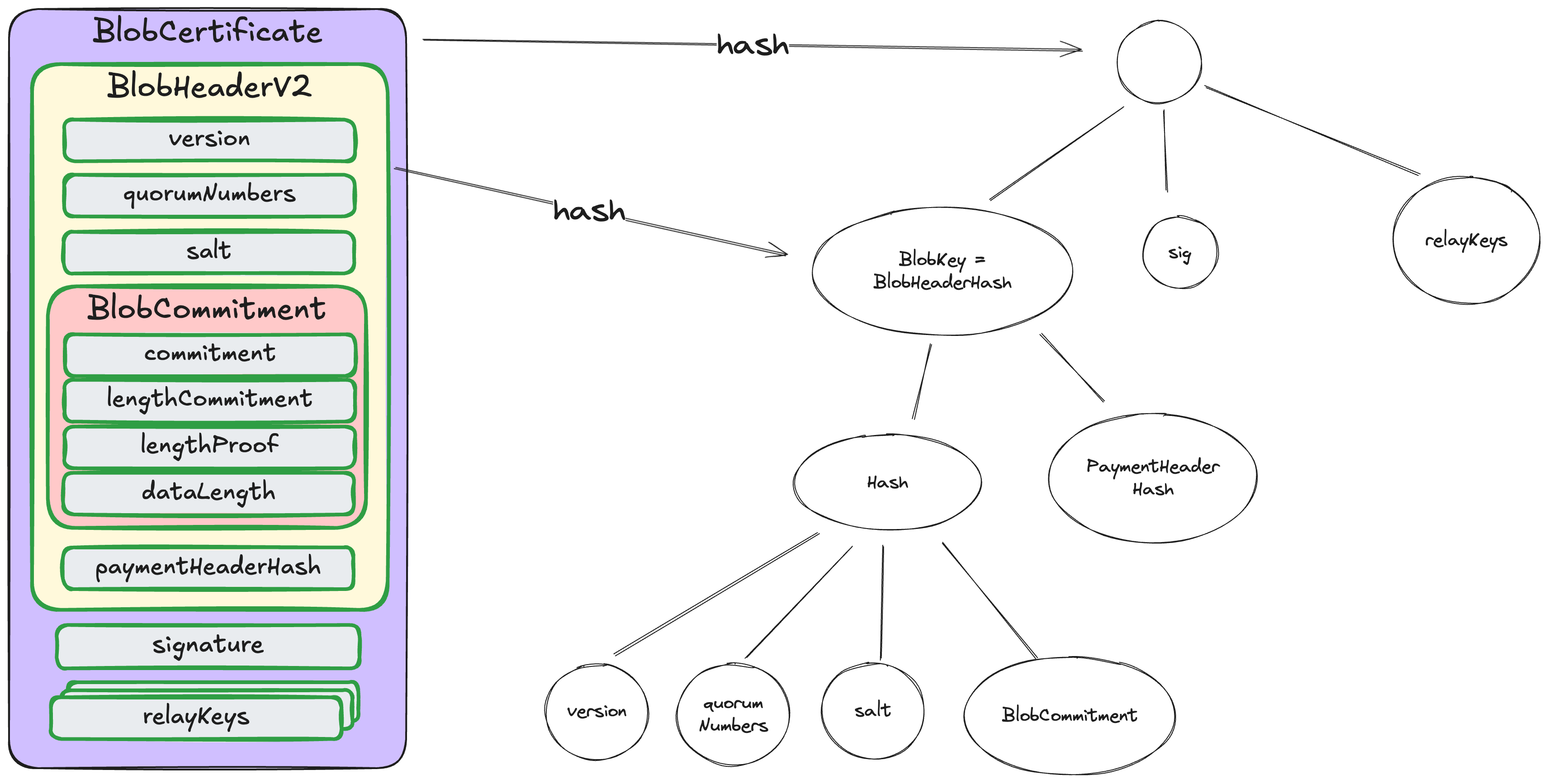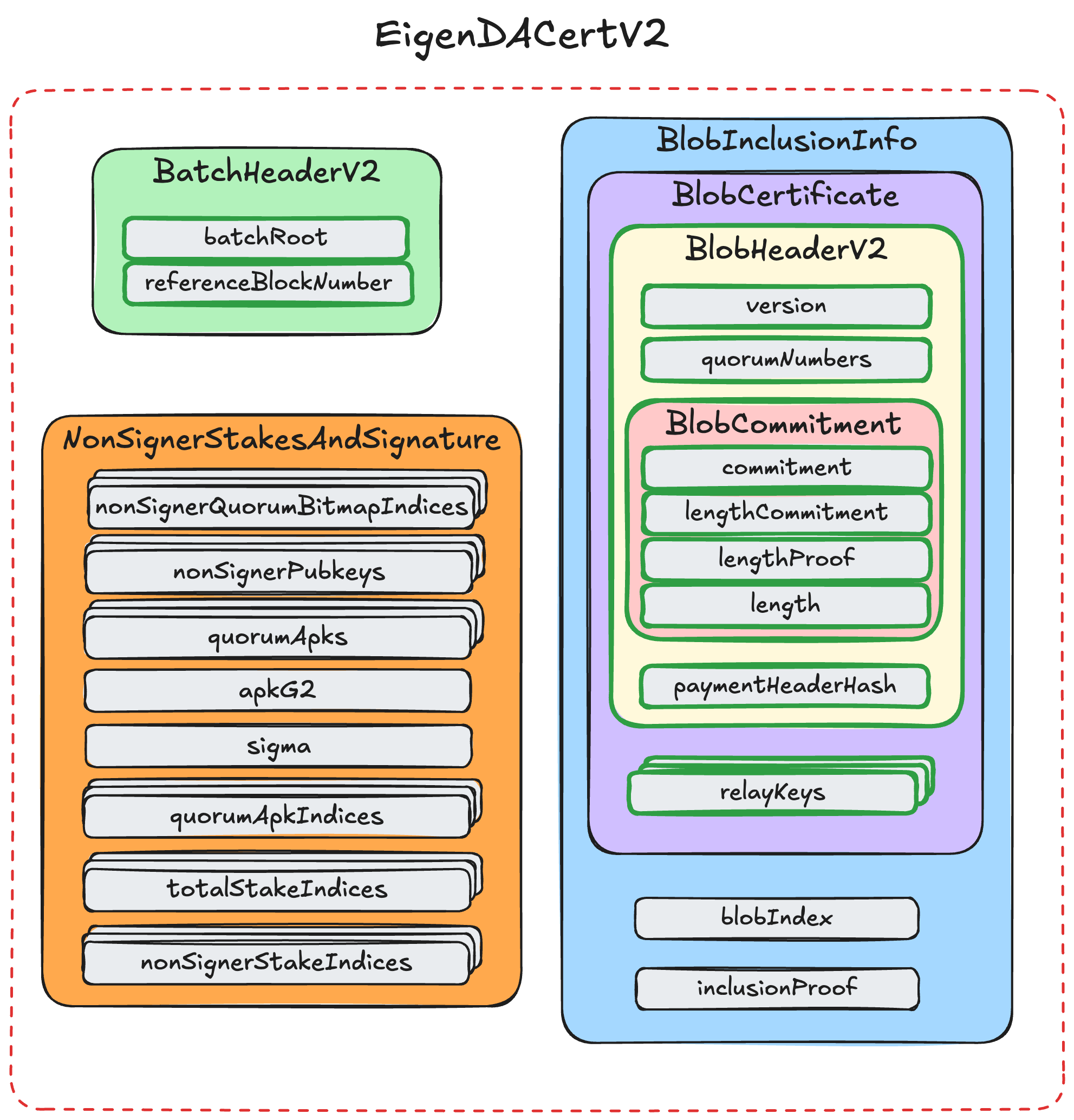Data Structs
The diagram below represents the transformation from a rollup payload to the different structs that are allowed to be dispersed

Payload
A client payload is whatever piece of data the EigenDA client wants to make available. For optimistic rollups this would be compressed batches of txs (frames). For (most) zk-rollups this would be compressed state transitions. For AVSs it could be Proofs, or Pictures, or any arbitrary data.
A payload must fit inside an EigenDA blob to be dispersed. See the allowed blob sizes in the Blob section.
EncodedPayload
An encodedPayload is the bn254 encoding of the payload. This is an intermediary processing step, but useful to give a name to it. The encoding must respect the same constraints as those on the blob:
Every 32 bytes of data is interpreted as an integer in big endian format. Each such integer must stay in the valid range to be interpreted as a field element on the bn254 curve. The valid range is 0 <= x < 21888242871839275222246405745257275088548364400416034343698204186575808495617.
The golang payload clients provided in the eigenda repo currently only support encoding version 0x0, which encodes as follows:
[0x00, version_byte, big-endian uint32 len(payload), 0x00, 0x00,...] +
[0x00, payload[0:31], 0x00, payload[32:63],...,
0x00, payload[n:len(payload)], 0x00, ..., 0x00]
where the last chunk is padded with 0s such that the total length is a multiple of 32 bytes.
For example, the payload hello would be encoded as
[0x00, 0x00, 0x00, 0x00, 0x00, 0x05, 0x00, 0x00,...] +
[0x00, 'h', 'e', 'l', 'l', 'o', 0x00 * 26]
PayloadPolynomial
EigenDA uses KZG commitments, which represent a commitment to a function. Abstractly speaking, we thus need to represent the encodedPayload as a polynomial. We have two choices: either treat the data as the coefficients of a polynomial, or as evaluations of a polynomial. In order to convert between these two representations, we make use of FFTs which require the data to be a power of 2. Thus, PolyEval and PolyCoeff are defined as being an encodedPayload padded with 0s to the next power of 2 (if needed) and interpreted as desired.
Once an interpretation of the data has been chosen, one can convert between them as follows:
PolyCoeff --FFT--> PolyEval
PolyCoeff <--IFFT-- PolyEval
Whereas Ethereum treats 4844 blobs as evaluations of a polynomial, EigenDA instead interprets EigenDA blobs as coefficients of a polynomial. Thus, only PolyCoeffs can be submitted as a blob to the Disperser. Each rollup integration must thus decide whether to interpret their encodedPayloads as PolyCoeff, which can directly be dispersed, or as PolyEval, which will require IFFT’ing into a PolyCoeff before being dispersed.
Typically, optimistic rollups will interpret the data as being evaluations. This allows creating point opening proofs to reveal a single field element (32 byte chunk) at a time, which is needed for interactive fraud proofs (e.g. see how optimism fraud proves 4844 blobs). ZK rollups, on the flip side, don't require point opening proofs and thus can safely save on the extra IFFT compute costs and instead interpret their data as coefficients directly.
Blob
A blob is a bn254 field elements array that has a power of 2. It is interpreted by the EigenDA network as containing the coefficients of a polynomial (unlike Ethereum which treats blobs as being evaluations of a polynomial).
An encodedPayload can thus be transformed into a blob by being padded with 0s to a power of 2, with size currently limited to 16MiB. There is no minimum size, but any blob smaller than 128KiB will be charged for 128KiB.
BlobHeader And BlobCertificate
The blobHeader is submitted alongside the blob as part of the DisperseBlob request, and the hash of its rlp serialization (blobKey aka blobHeaderHash) is a unique identifier for a blob dispersal. This unique identifier is used to retrieve the blob.

Refer to the eigenda protobufs documentation for full details of this struct.
DACertificate
A DA Certicate (or short DACert) contains all the information needed to retrieve a blob from the EigenDA network, as well as validate it.

A DACert contains the three data structs needed to call verifyDACertV2 on the EigenDACertVerifier.sol contract. Please refer to the eigenda core spec for more details, but in short, the BlobCertificate is included as a leaf inside the merkle tree identified by the batch_root in the BatchHeader. The BlobInclusionInfo contains the information needed to prove this merkle tree inclusion. The NonSignerStakesAndSignature contains the aggregated BLS signature sigma of the EigenDA validators. sigma is a signature over the BatchHeader.

AltDACommitment
In order to be understood by each rollup stack’s derivation pipeline, the cert must be prepended with header bytes, to turn it into an altda-commitment respective to each stack:
- op prepends 3 bytes:
version_byte,commitment_type,da_layer_byte - nitro prepends 1 byte:
version_byte